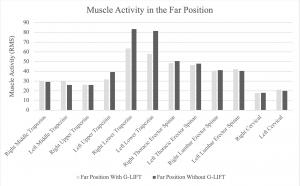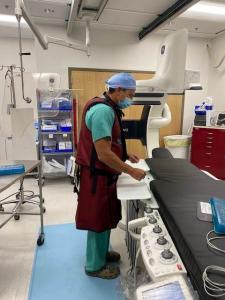Pilot Study Demonstrates GLiFT Radiation Protection System Reduces Muscle Activity and Strain for Healthcare Providers
Biomedical evaluation of Salus Scientific’s solution highlights ergonomic benefits in challenging clinical positions
By employing the Orthopedic Principle of Force Transfer, the GLiFT system provides an ergonomic advantage, helping to alleviate the musculoskeletal problems that our health care providers endure.”
CHARLESTON, SOUTH CAROLINA, UNITED STATES, September 6, 2024 /EINPresswire.com/ -- Salus Scientific is thrilled to announce the findings from the first biomechanical study of its GLiFT Radiation Protection System, conducted by Michel Heijnen at the University of North Carolina Wilmington. The pilot study showed a trend toward statistical significance with a P-Value of 0.06 for a reduction in muscle activity in the trapezius muscles, especially in extreme ergonomic positions such as those required during left radial artery access procedures (Heijnen, 2024). — Todd Flohr
Surgeons and interventionalists often face long hours, intensive training, and immense pressure, leading to a high incidence of work-related musculoskeletal injuries. A systemic review indicated that 41.6% of surgeons operate in a slouched position (Xu et al., 2023), and a survey of 95 surgeons revealed that 91 had experienced work-related musculoskeletal complaints, with neck and back pain being the most common (Rata et al., 2021). The average prevalence of these injuries among surgeons ranges from 50% to 70%, with some studies reporting incidence as high as 80% (Scheidt et al., 2022; Rata et al., 2021, Lucasti et al., 2022).
These injuries are exacerbated by the awkward positioning and the heavy lead aprons required for radiation protection during surgery (Swank et al., 2022). A typical lead vest and skirt can weigh approximately 20 pounds, contributing to thoracic kyphosis and increased lateral deviation from postural loading. With repeated use, this extra weight places constant stress on the posterior back muscles, leading to pain and injury.
The GLiFT Radiation Protection System addresses these challenges by reducing muscle activity in critical muscle groups. The pilot study highlights the system's benefits in maintaining ergonomic positions during Cardiac Cath Procedures, reducing strain in the trapezius muscles, especially in extreme postures commonly used by physicians.
"This groundbreaking study lays the foundation for future clinical evaluations to further validate the benefits of the GLiFT system for healthcare workers in the fluoroscopy suite," said Todd Flohr, CEO of Salus Scientific. "By employing the Orthopedic Principle of Force Transfer, the GLiFT system provides an ergonomic advantage, helping to alleviate the musculoskeletal problems that our health care providers endure."
The GLiFT system's ergonomic benefits are critical in reducing the risk of musculoskeletal injuries among surgeons, interventionalists and healthcare providers, promoting a safer and more comfortable working environment. As Salus Scientific continues to innovate in the field of
radiation protection, this pilot study underscores the company's commitment to advancing healthcare technology that protects both medical professionals and patients.
For more information about the GLiFT Radiation Protection System and Salus Scientific's commitment to innovative medical technologies, visit Salus Scientific: https://theglift.com/
References:
Heijnen, M (2024) Effectiveness of the GLIFT Device on Reducing Muscle Activity in Posterior Muscles
Lucasti C, Maraschiello M, Slowinski J, Kowalski J. Prevalence of Back and Neck Pain in Orthopaedic Surgeons in Western New York. Journal of the American Academy of Orthopaedic Surgeons. Global Research & Reviews. 2022 Jan;6(1):e21-00252. DOI: 10.5435/jaaosglobal-d-21-00252. PMID: 34989709; PMCID: PMC8740880.
Rață, A. L., Barac, S., Garleanu, L. L., & Onofrei, R. R. (2021). Work-Related Musculoskeletal Complaints in Surgeons. Healthcare (Basel, Switzerland), 9(11), 1482. https://doi.org/10.3390/healthcare9111482
Xu, A. L., Covarrubias, O. G., Yakkanti, R. R., Sotsky, R. B., & Aiyer, A. A. (2023). The Biomechanical Burden of Orthopaedic Procedures and Musculoskeletal Injuries Sustained by Orthopaedic Surgeons: A Systematic Review. JBJS reviews, 11(1), e22.00202.
About Salus Scientific
Salus Scientific Corp., a Charleston, South Carolina-based company established in 2021, produces innovative medical technologies benefiting both healthcare workers and patients. The company’s first commercialized medical device, the GLift Pro, is a next-generation radiation protection system that was designed to help alleviate the musculoskeletal issues associated with wearing heavy lead aprons. To learn more, visit https://theglift.com/.
Todd Flohr
Salus Scientific
todd.flohr@salusscientific.com
Legal Disclaimer:
EIN Presswire provides this news content "as is" without warranty of any kind. We do not accept any responsibility or liability for the accuracy, content, images, videos, licenses, completeness, legality, or reliability of the information contained in this article. If you have any complaints or copyright issues related to this article, kindly contact the author above.



